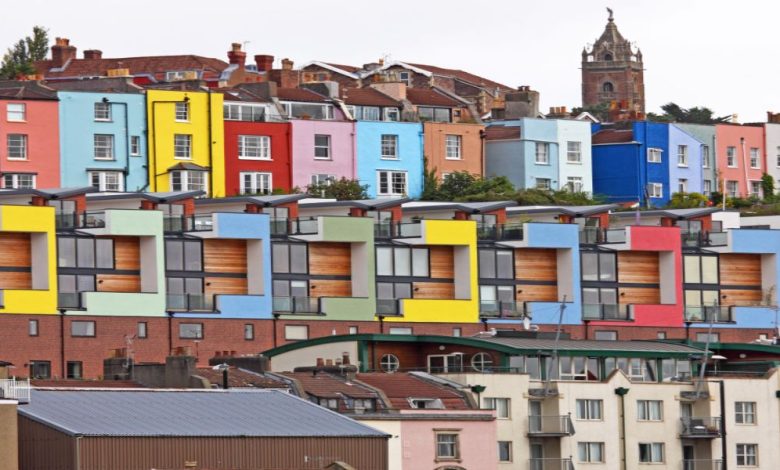
Bristol, a vibrant city in southwest England, boasts a rich history and a unique identity that’s deeply intertwined with street art.In Bristol you can find many things to do without spending a penny. That is why Bristol is a good city to visit.
From early tags and murals to internationally renowned artists like Banksy, Bristol’s street art scene has evolved into a dynamic and ever-changing canvas, reflecting the city’s culture, social issues, and creative spirit.
1. Early Days: Tags and Lettering (1980s)
The story of Bristol’s street art scene begins in the 1980s, mirroring a global trend. Inspired by the burgeoning hip-hop culture in the US, young Bristolians started leaving their mark on the city walls with spray paint. These early expressions primarily consisted of tags and lettering, often serving as a way to claim territory and express individuality.
2. Rise of Wild Style (Late 1980s – Early 1990s)
Building upon the foundation of tags, a new style emerged in the late 1980s and early 1990s: Wild Style. This movement emphasized intricate lettering, bold colors, and elaborate designs. Crews like the “Bristol Creative Collective” and “3D” (Robert Del Naja, later of Massive Attack fame) became prominent, leaving their signature wild style pieces across the city.
3. Enter The Barton Hill Youth Club (Early 1990s)
The Barton Hill Youth Club played a pivotal role in nurturing Bristol’s early street art scene. This community center provided a space for young artists to hone their skills and collaborate. From organizing workshops and exhibitions to encouraging responsible spray painting practices, the Barton Hill Youth Club helped foster a sense of ownership and pride in the city’s street art.
4. Walls On Fire & The Explosion of Street Art (1998)
A landmark event in 1998, the “Walls on Fire” festival, truly put Bristol’s street art scene on the map. This international festival brought together renowned street artists from around the world, creating a vibrant showcase of talent and styles. The festival’s success not only beautified the city but also sparked a wider appreciation for street art as a legitimate art form.
5. Banksy and the Global Spotlight (Late 1990s – Present)
Perhaps the most recognizable figure associated with Bristol street art is the enigmatic Banksy. Emerging in the late 1990s, Banksy’s witty stencils and satirical commentary on social and political issues quickly gained international attention. While his true identity remains a mystery, Banksy’s work in Bristol, including the iconic “Girl with Balloon,” has become a major tourist draw and a source of immense pride for the city.
6. Beyond Banksy: A Diverse Street Art Scene (Present)
While Banksy may be the most famous, Bristol’s street art scene thrives with a diverse range of talented artists. From established names like Inkie and Cheo to up-and-coming talents, the city’s walls are constantly evolving with new and thought-provoking pieces. Exploring these works, often hidden in unexpected corners, is a fantastic way to discover Bristol’s vibrant artistic energy and social pulse.
7. Street Art as a Catalyst for Change (Present)
Street art in Bristol goes beyond aesthetics. Many artists use their work to raise awareness about social issues, environmental concerns, and political injustices. These powerful pieces spark conversations, challenge the status quo, and inspire positive change.
8. Street Art Tours: Unveiling the Hidden Gems (Present)
For visitors, several guided street art tours offer a deeper understanding of Bristol’s artistic landscape. These tours, led by knowledgeable guides, take you to hidden gems, provide insights into the artists’ styles and messages, and allow you to appreciate the intricate details of the artwork.
9. Street Art and Community Engagement (Present)
Street art isn’t just about creating impressive visuals; it’s also about fostering a sense of community ownership. Many Bristol neighborhoods collaborate with artists to create murals that reflect their local identity and pride. This collaborative spirit strengthens community bonds and encourages residents to take ownership of their public spaces.
10. The Future of Street Art in Bristol (Present – Future)
Bristol’s street art scene is constantly evolving, reflecting the city’s ever-changing cultural landscape. With new artists emerging and established ones pushing boundaries, the future of street art in Bristol promises to be exciting and dynamic.
11. A City Canvas: Exploring Bristol’s Street Art Scene
The beauty of Bristol’s street art lies in its accessibility. Unlike museums with opening hours and entry fees, these vibrant artworks are free to explore anytime. So, lace up your walking shoes, grab a map (or use a street art app!), and embark on your own self-guided tour.
Whether you’re a seasoned art enthusiast or simply curious about this unique form of expression, Bristol’s ever-changing canvas offers something for everyone. As you navigate the city streets, keep your eyes peeled for hidden gems, appreciate the artistic skill, and ponder the messages these artworks convey. Remember, street art is a living dialogue, so feel free to snap photos, share your discoveries on social media, and contribute to the ongoing conversation about art, community, and social change.
Bristol’s street art scene is more than just colorful murals; it’s a testament to the city’s creative spirit, a platform for social commentary, and a source of pride for its residents. So, on your next visit to Bristol, don’t forget to look beyond the traditional tourist attractions. Explore the hidden corners, marvel at the artistic expressions, and become part of the vibrant story that unfolds on Bristol’s ever-evolving canvas.









